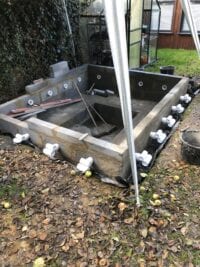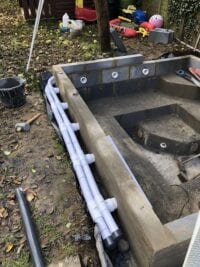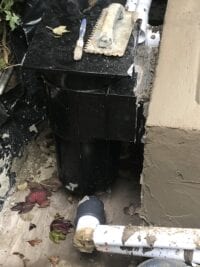Plumbing is kind of essential when building your own Hot Tub. In this article, I am going to discuss all the things you should be thinking about in the planning stage that are plumbing related. The success of your DIY Built Hot Tub relies on water circulating and air entering your hot tub. Read on to learn more about your plumbing considerations for your DIY Hot Tub Build.
Plumbing your DIY Hot Tub
After the physical integrity of the hot tub structure, the plumbing is probably the next most import part. After all, without the plumbing, you don’t have a hot tub. As an overview, the concept of a hot tub is pretty simple. Tub is full of water.
Water is flowing through the skimmer at the top and through the drains (drawn in by the pump inlet) at the bottom. Water flows from skimmer and drains into the filter, from the filter into the heater.
From the heater into the pump and from the pump out into the jets. The concept is basic right? Correct, it is not a difficult concept. However, there are a few challenges to get to this point.
Gunite Jet Bodies and Jets
This was one of the more difficult things for me to get my head around when I was planning my build. I had never seen any of these components so I was searching for diagrams and videos on YouTube. None of them really enabled me to understand exactly how they worked and I was taking a bit of a chance when I ordered them as they are not cheap.
I knew that I needed this style of jet as they needed to go through my breeze blocks and conceptually, this was similar to the gunite systems that they are designed to be used in. Let’s start with what these components are not. You will not find these on your plastic shell hot tubs. They are not suitable for this at all. Everything is different.
These components are really designed for fancy sprayed in concrete construction method that I touched on earlier “shotcrete” or “gunite” – essentially concrete sprayed into a metal construction under high pressure and then skimmed smooth. Very technical and difficult to do – not even for the competent DIYer. So these components are essentially designed to be set into concrete. Ok, we’re now onto something here. With our breeze block construction, we can make use of these components. Before we talk about how to fit them, let’s take a step back and explain how they actually work as this was the bit I struggled to understand.

The “gunite jet system” comes in lots of different parts that need to be put together. The part that I didn’t understand was that the gunite system mixes air and water to give a stronger jet. There is a bit of physics involved here. I’m no physics expert so I’ll explain it in terms that I understand myself. I was under the impression that most of the power of the water jet came from the pump – this is not the case. The power of the jet comes from the mixing of air and water in the gunite body which in turn produces a stronger jet.
There are two ways in which you can get air into the system. Firstly is by using “Venturi” vents. The Venturi concept is where water moving across an opening at speed will draw air into the system. This is why you see on some plastic shell tubs vents that can be opened and closed to adjust the jet strength. The other option and the method that I opted for was to go for a separate blower. Think “hair dryer” – it blows warm air through the pipes to mix with the water in the gunite bodies. Don’t be under any illusion that there is any significant heat generated by the blower that will make any difference to the overall temperature of your water – it will not. It will however give you some nice bubbly jets – exactly what we are looking for.
Looking closer at the plumbing, there are actually two sets of pipes that run around your hot tub. The first is for the air and the second is for the water. They are separate and they only mix in the gunite bodies before they hit the jets.
The gunite systems are made up of a Gunite body which is concreted into the hut tub. In our build of breeze block, you need a large bore drill to cut the holes in the cinder block. I managed it with a good quality hammer drill but you can hire specialist bore drills if you wish to make the job easier. Once these bodies are concreted in, they are ready for the piping.
They will take an air feed (from the blower) on the rear of the unit and underneath, a water feed from the pump. Inside the gunite jet, there is an additional water pipe which screws into the body and had the jet housing attached to the end. All these are separate components that need cementing together with pvc cement. The Jet (you can decide the style later on) can then be pushed into place and interchanges if you so wish. The jet body is where the water and the air mix to give a more powerful jet.
As we are mixing water and air, we have to make sure that we have a one-way valve before the blower so that it is not possible for any water to get into the blower as that would trip your electricity supply and damage your blower, so you dont want that.
Think about final thickness of tiles. This was an area that I didn’t get quite right with the Gunite Bodies. In some of my jets I left too much room so they stick out a little. Not enough that people notice but being the perfectionist, I know. I also had a couple of them that were too tight which presents a bit of a challenge when you are trying to fit the jet bodies into the unite bodies. You end up with a gap which means that air escapes from behind the jet instead of being pushed through the jet in its entirety. Its not game over by any stretch of the imagination, but if you can get this right and allow the right amount of space between the wall and the unit body, allowing for the tile then you should have a very nice flush finish at the end.
Make sure your gunite bodies are perpendicular to the walls. Another mistake that I made with the gnat bodies was that they were not cemented into the blocks totally perpendicular so that means when you put your jets in, they dont sit flush to the tiles. Again, mine are not at an angle that is noticeable, but I know they are not 100%.
Jet Considerations
How many jets are you going to opt for? This may seem like a simple question but it does affect a few things. Firstly, you have to make sure that your pump is going to be powerful enough to push the water through the jets. Again, there is some physics here but explained simply, the more jets you have, the less force there is as the same amount of force has to spread across all the jets. Rule of thumb from what I read on the pump front is that a 3hp pump can cope with up to 20 jets. I have a 3hp pump and I am using 15. There is plenty of power from the jets so I would say that adding a few more would not have made a big different to the power of each jet.
To expand on this point further, the most important thing is how much flow is there to the jets. Each brand of jets has its own flow requirements in order to function correctly. The waterway jets that I used needed 10 GPM of flow to run correctly.
The pump, depending on the size will then generate a maximum amount of flow at any given head height or distance from the Hot Tub itself. Once you have this number you can then calculate the number of jets.
For example, if you would like to have 16 jets, you need to have 160 GPM of flow in order to run them correctly at your given head height.
Pretty straight ward calculations when you know how!
Where are you going to position your jets? The shop bought tubs have jets all over the place and lots of them. They are not as powerful as the gunite jets but they give the same result.
What I did was placed the jets so that they would be in the middle of my back when I was sat on the seat and they are in a uniform line all around the tub. The number and position of the jets is going to affect your plumbing. The more jets and the more ambitious the layout, the more difficult the plumbing.
Pipe Layout
At this point, you really need to have decided where your “control room” is going to be as you need to work on the pipe layout. If you remember, we said that the concept of the hot tub plumbing is quite simple. Water is drawn in through the skimmer and through the bottom two inlets pushed through the pump and back out through the jets. What you are trying to do with the jets is get the most power out of them. Again, I am sure that there is some physics that can be used to explain this, but to explain it in a way that I understand it, two shorter runs from the pump creates more pressure than a single run. Also two terminated pipe runs create more pressure than loop. As my tub is square and if you are stood facing it, I have the “control room” to the left front. My pipe runs split almost straight off the pump and they run down each side to meet, but not connect, in the top right hand corner. As we are going to be mixing the air and water at each jet, you are running two sets of pipes and they are different sizes.

Types of Pipe for your DIY Hot Tub
Pipes come in all shapes and sizes however with hot tubs, there are two sizes and two types. Firstly, there is rigid pipe and flexible pipe.
Now, do not kid yourself here as the “flexible pipe” is not flexible! Yes, you can bend it a little but is very hard and you will not be tying any knots in it.
This was a mistake that I made as my life would have been made easier if I had used some 90 degree junctions rather than trying to bend pipe. I had s flexible bent pipe coming up through the steps from the bottom drains. I was trying to minimise joints as I thought that more joints would potentially mean more leaks. However I was wrong on this as the pipe and connectors are so well made that an almost perfect joint is made each time with plenty of PVC pipe cement you will be all set. Keeping the pipe neat and running parallel with good joints leads to lowering the probability of leaks. In my case, I knew exactly where the first leak was going to be as I ended up with an overly complicated joint on a funny angle that I couldn’t quite get to in the “control room”. Low and behold, when I filled up that was the first leaking point. I’ll talk later about what I used to fix leaks as I tried a few products and they didn’t work. OK, so back to our flexible pipes.
These pipes are pressure rated so they are not the same as household plumbing pipes. I used Waterway pipes in my construction (again one of those American brands) and they are really well made pieces of kit. There was also pretty much very combination of connector, bush or corner piece that I could think of. The pipes went together and felt so solid and well made I would definitely recommend Waterway pipes. I’m sure other brands are just as good but I only have my own experience to draw from on this point. I mentioned that there is also right pipe available. I’ve no evidence for this but my thought was that if the pipe was flexible then it would be able to cope a little better with the pressure and would be less likely to pop out of a joint, so I opted for flexible. Its a little bit more expensive but in the whole bigger picture of cost, it is not going to break the bank.
Hot tub pipes, as well as being pressure rated are a specific size. Water pipes are 2” in diameter and air pipes are 1.5”. This is different from swimming pools. Also, something to note here is that an imperial 2” pipe is NOT the same as a 63mm metric pipe. At first glance it would look as if they are as it is hard to see the difference. However, there is a difference of a millimetre and a bit. This does make a difference when you are trying to make water tight joints that are going to hold under signigicant pressure. Make sure that the parts that you buy all match. With Waterway what I will say is that they do have adaptors to take you from 63mm pipe back to the 2” as I used a couple of them on the skimmer. I’ll talk about this next.
The Skimmer for your DIY Hot Tub
Now that you have decided how many jets you are having, where they are going and how you are going to plumb them in, you now need to consider the Skimmer’s position. This is a little more tricky than you might think. Firstly, you want to have the skimmer as close to your pump in the “Control Room” as possible. Secondly, the height of the Skimmer is going to dictate the water level. The ‘perfect’ final water level in the hot tub is that it comes half way up the skimmer. This is to allow any debris to flow freely into it where larger pieces of debris, or in my case, usually the kids toys, end up in the basket. Smaller leaves and bits pass through and are caught in your filter.
The other thing that you have the consider regarding plumbing your DIY Hot Tub, specifically regarding the Skimmer is that your skimmer is the final top position of the access grill. This was something that I got a little bit wrong on two cases. Firstly, I under estimated the overall height of the skimmer when I had added a 90 degree bend on the bottom to direct water towards my pump. For me, this meant getting out the hammer drill and having to break another 20cm of concrete that I had laid so that it would fit. Secondly, I also got the height a little wrong so it doesn’t sit flush with the deck that I have put in afterwards. It wasn’t a big deal as I made a cover to fit but in a perfect world, it would have been flush.
The size of the skimmer that you choose is going to be dictated by the size and volume of water you are going to have in your tub. Check with the manufacturer for what they suggest. I have 2800 litres which has meant that I needed to opt for a swimming pool skimmer. I went with a brand and choose the Certakin brand as they are the ones that you regularly find in swimming pools. My tub was too large to consider a hot tub one. This posed a couple of difficulties. One was that it was actually on the metric sized 63mm pipe and I was of course on the 2” water. A bush and 90 degree bend from Waterway sorted that out. The next thing was avoiding the “swimming pool tax” as I like to call it. By shopping around on the internet I managed to save about 90 pounds just by googling the model. This was even better than the trade deal that I was getting from John the pool man. He was just not able to compete on price on that part so it is always worth shopping around.
Hope you have enjoyed this Article – do check out my board on Pinterest.
[/fusion_text][/fusion_builder_column][/fusion_builder_row][/fusion_builder_container][fusion_builder_container hundred_percent=”no” hundred_percent_height=”no” hundred_percent_height_scroll=”no” hundred_percent_height_center_content=”yes” equal_height_columns=”no” menu_anchor=”” hide_on_mobile=”small-visibility,medium-visibility,large-visibility” status=”published” publish_date=”” class=”” id=”” border_color=”” border_style=”solid” margin_top=”” margin_bottom=”” padding_top=”” padding_right=”” padding_bottom=”” padding_left=”” gradient_start_color=”” gradient_end_color=”” gradient_start_position=”0″ gradient_end_position=”100″ gradient_type=”linear” radial_direction=”center center” linear_angle=”180″ background_color=”” background_image=”” background_position=”center center” background_repeat=”no-repeat” fade=”no” background_parallax=”none” enable_mobile=”no” parallax_speed=”0.3″ background_blend_mode=”none” video_mp4=”” video_webm=”” video_ogv=”” video_url=”” video_aspect_ratio=”16:9″ video_loop=”yes” video_mute=”yes” video_preview_image=”” filter_hue=”0″ filter_saturation=”100″ filter_brightness=”100″ filter_contrast=”100″ filter_invert=”0″ filter_sepia=”0″ filter_opacity=”100″ filter_blur=”0″ filter_hue_hover=”0″ filter_saturation_hover=”100″ filter_brightness_hover=”100″ filter_contrast_hover=”100″ filter_invert_hover=”0″ filter_sepia_hover=”0″ filter_opacity_hover=”100″ filter_blur_hover=”0″ type=”legacy”][fusion_builder_row][fusion_builder_column type=”1_1″ layout=”1_1″ spacing=”” center_content=”no” link=”” target=”_self” min_height=”” hide_on_mobile=”small-visibility,medium-visibility,large-visibility” class=”” id=”” hover_type=”none” border_color=”” border_style=”solid” border_position=”all” border_radius=”” box_shadow=”no” dimension_box_shadow=”” box_shadow_blur=”0″ box_shadow_spread=”0″ box_shadow_color=”” box_shadow_style=”” padding_top=”” padding_right=”” padding_bottom=”” padding_left=”” margin_top=”” margin_bottom=”” background_type=”single” gradient_start_color=”” gradient_end_color=”” gradient_start_position=”0″ gradient_end_position=”100″ gradient_type=”linear” radial_direction=”center center” linear_angle=”180″ background_color=”” background_image=”” background_image_id=”” background_position=”left top” background_repeat=”no-repeat” background_blend_mode=”none” animation_type=”” animation_direction=”left” animation_speed=”0.3″ animation_offset=”” filter_type=”regular” filter_hue=”0″ filter_saturation=”100″ filter_brightness=”100″ filter_contrast=”100″ filter_invert=”0″ filter_sepia=”0″ filter_opacity=”100″ filter_blur=”0″ filter_hue_hover=”0″ filter_saturation_hover=”100″ filter_brightness_hover=”100″ filter_contrast_hover=”100″ filter_invert_hover=”0″ filter_sepia_hover=”0″ filter_opacity_hover=”100″ filter_blur_hover=”0″ last=”true” border_sizes_top=”0″ border_sizes_bottom=”0″ border_sizes_left=”0″ border_sizes_right=”0″ first=”true”][fusion_blog layout=”large” blog_grid_columns=”” blog_grid_column_spacing=”” blog_masonry_grid_ratio=”” blog_masonry_width_double=”” equal_heights=”no” number_posts=”6″ post_status=”” offset=”0″ pull_by=”category” cat_slug=”” exclude_cats=”” tag_slug=”” exclude_tags=”” orderby=”date” order=”DESC” thumbnail=”yes” title=”yes” title_link=”yes” content_alignment=”” excerpt=”” excerpt_length=”” strip_html=”yes” meta_all=”yes” meta_author=”yes” meta_categories=”yes” meta_comments=”yes” meta_date=”yes” meta_link=”yes” meta_tags=”yes” scrolling=”pagination” grid_box_color=”” grid_element_color=”” grid_separator_style_type=”” grid_separator_color=”” padding_top=”” padding_right=”” padding_bottom=”” padding_left=”” hide_on_mobile=”small-visibility,medium-visibility,large-visibility” class=”” id=”” /][/fusion_builder_column][/fusion_builder_row][/fusion_builder_container]